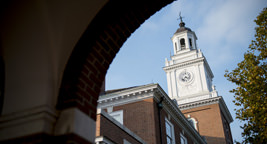One University
Tomorrow’s most pressing questions will not be confined to silos, and neither will be the solutions. From its earliest days, Johns Hopkins has embraced robust collaboration across world-class disciplines, understanding that both our intellectual curiosity and our drive to advance humanity are better served if we work together.
The university will build its future on strong and vibrant disciplines. At the same time, we will seek to remove the barriers that stand in the way of interdisciplinary scholarship and research—fostering interactions across the university that respect the discipline of the disciplines while promoting the cross-pollination of ideas that will catalyze a new generation of discovery.
The Goals
Selectively invest in programs that support our core academic mission.
As our schools consider the future of their academic programs, they will need to make decisions about how to invest in a disciplined and purposeful manner. A strategic process, one informed by objective data and sound analysis and premised on transparency and participation, should determine academic priorities. And the priorities that emerge from that process should guide budgetary and organizational decision making, not the other way around.
Since the Ten by Twenty was introduced, our university has made new academic commitments in a range of strategic areas, many of which are detailed in the Snapshots you will find along the side. For each of these commitments, and for future ones, the tests to which we should hold ourselves continue to be: Have we placed a premium on faculty leadership in strategic decision making? Have we employed an inclusive approach that comprises a multitude of voices? And, have we embraced assessment and data to inform our decisions, in order to make the smartest choices about where to direct our academic resources and energies in the face of funding challenges?
Strengthen our capacity for faculty-led interdisciplinary collaboration and launch a set of innovative cross-cutting initiatives that will contribute substantially to the world of ideas and action.
Johns Hopkins has long championed the role of interdisciplinary cooperation as a means of solving the world’s most fundamental questions and its most complex problems. However, universities are structured in ways that can impede the impulse of faculty to mount interdisciplinary endeavors, and so we must intentionally create conditions that encourage creative collisions at the crossroads of our divisions.
The last year and a half saw a number of such collaborative initiatives move forward, some in which we had made prior investments and others in areas entirely new. And as is appropriate for a strategic priority, we have begun to harness data to measure our progress. Among the early insights: The percentage of cross-divisional publications and grant proposals has increased in recent years, though both also showed a slight decline in the last measured year. In 2015, our schools are developing investments in new research programs and reviewing barriers to new collaborative educational programs to ensure that we are holding true to our aspirations in this area.
Enhance the impact of Johns Hopkins Medicine, the Bloomberg School of Public Health, and the School of Nursing as the world’s pre-eminent academic health sciences enterprise by deepening collaboration among these entities and with disciplines in other parts of the university and across the globe.
The Johns Hopkins East Baltimore campus is home to the pre-eminent academic health sciences enterprise in the world, one of the few where elite schools of nursing, medicine, and public health are all within steps of a world-class hospital, and where faculty collaboration among them is part of the culture. To meet the many emergent challenges of health care and delivery in a changing world, our East Baltimore schools will need to build on that tradition, forging new collaborations among themselves and beyond.
The Snapshots you will find along the side show a depth and diversity of possibilities: ambitious new research endeavors, cutting-edge academic collaborations, and adept and inspiring responses to crises. The work of building these collaborations will need to continue, but our achievements once again affirm that our many talents and resources place us in a singular position to meet the health sciences challenges of tomorrow.



